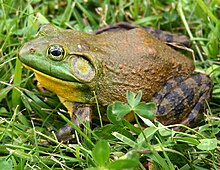User:Bullfrogman~enwiki
| American Bull Frog | |
|---|---|

| |
| Bullfrog, Rana catesbeiana | |
| Scientific classification | |
| Kingdom: | |
| Phylum: | |
| Class: | |
| Order: | |
| Family: | |
| Genus: | |
| Species: | R. catesbeiana
|
| Binomial name | |
| Rana catesbeiana | |
- For the software company, see Bullfrog Productions
The American Bull Frog (Rana catesbeiana) is an amphibian, a member of the family Ranidae, or "true frogs". This frog is found in ponds, lakes, or marshland mainly where the water is quiet and covered with plants. The bullfrog's diet consists of insects, and larger prey such as small mammals, birds, turtles, snakes, and other anurans. The bullfrog is native to North America, but has been introduced to a few places in Europe as well. As it forms a risk to some ecosystems in Europe, there is an effort to prevent its spread there.
The bullfrog's skin can be a dark green to brown, and their eyes are golden. The bullfrog can measure up to 20 centimeters in length, not including the length of the legs. They can also weigh up to 750 grams. Male bullfrogs are also a bit smaller, as with most amphibians.
A bullfrog uses skin, Buccal Cavity, and lungs for respiration. Cutaneous ("skin") gas exchange is very important in all amphibians.
The skeleton of an adult frog consists of bone, hyaline cartilage, and calcified cartilage. The calcified cartilage can be found throughout the body of the frog, its particularly more noticeable in the epiphyses of the long bones in the limbs and shoulder-gridle, etc. The frog not only has a scalpula, but a suprascalpula which allows for greater range of motion for long jumps. In the frog the radius and ulna have become fused into a single bone, the radio-ulna, and the tibia and fibula have become fused into a single bone, the tibio-fibula.
The vertebrae of the frog comprise ten bones; nine are true vertebrae, and the rod-shaped urostyle that is almost as long as the other nine. The head of the frog is flat but its form depends on the extensive separation of the jaw bones; the orbital cavities and the horizontal direction of their floor also have an effect on the form of the head. The central nervous system of the frog is made up of the spinal cord and the brain, where the spinal cord is a bit smaller than the brain. The peripheral nervous system contains the cranial nerves and spinal nerves.
The male reproductive organs are the testes and their duct and the female have their ovaries. In spring at night the male calls the female from the water. The female lays up to 25,000 eggs and these eggs will become tadpoles. Their metamorphosis brings them the organs that are only found in the adult frogs and takes between 12-24 months. There are three major changes that take place during the metamorphosis: 1) Premetamorphisis which is when the embryo genesis and growth and development occur, during this time the thyroid gland is absent. 2) Prometamorphisis is the period in which the concentration of the endogenous thyroid hormone rises 3) Metamorphosis is the period when the tadpole's tail shrinks back into the frog's body. Other organs too undergo changes such as the liver and the intestine and the gills will be gone as well. The adult frog can live up to 15 years.

Bullfrogs provide a minor food source, especially in the southern side of America, and in some areas of the mid-West. In a few locations they are commercially cultured in ponds, but the traditional way of hunting them is to paddle or pole silently by canoe or flatboat in streams or swamps at night; when the frog call is heard, fix a strong light on the frog. The frog will not jump into deeper water as long as movement is slow and steady. When close enough, the frog is gigged and brought into the boat. The only parts eaten are the rear legs, which resemble small chicken drumsticks, and they are usually fried for consumption.
References[edit]
- "Rana catesbeiana". Integrated Taxonomic Information System. 6 February.
{{cite web}}: Check date values in:|date=and|year=/|date=mismatch (help)
